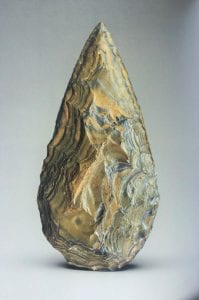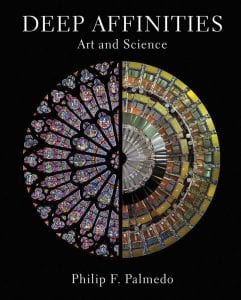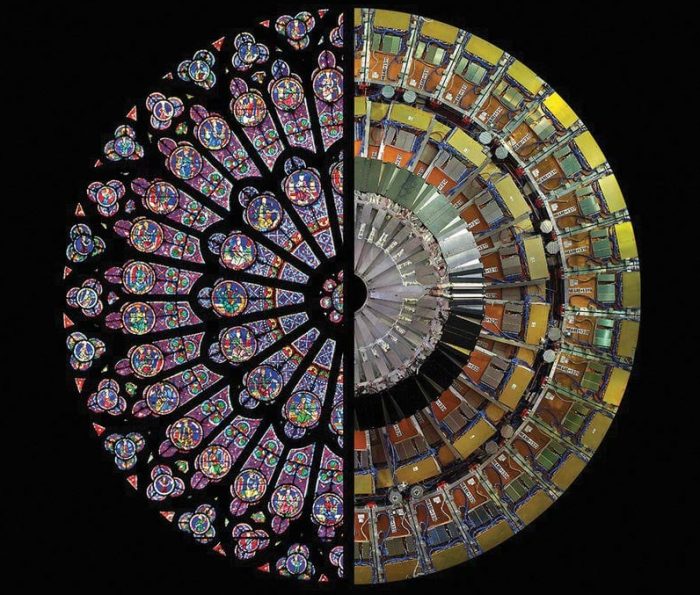Reviewed by Elizabeth Kahn Kaplan
St. James resident Philip Palmedo’s latest book, Deep Affinities: Art and Science, skillfully develops the premise that close observation and representation of the natural world, driven by “careful curiosity,” was the starting point of both art and science in the far distant past, and that their deep relationship — affinity — continues to the present.

A fascinating early chapter includes a reference to a work of sculpture dating from at least 50,000 BP (Before the Present), before Homo sapiens came to Europe. “A small stone that resembled a bird was collected by a Neanderthal and then modified to be more realistic. A hole was drilled for the eye, and the shape of the beak and tail was smoothed.” Palmedo offers evidence that this object and other stone carvings, as well as cave drawings created by our earliest ancestors, indicate that the origins of science and the starting point of art began with careful curiosity leading to observation of the natural world — the same influences that inspire the work of scientists and artists today.
As far back as 600,000 BP an aesthetic sensibility and a scientific instinct appeared in an ironstone hand ax found in South Africa; the early human who shaped it was concerned with form as well as function — with symmetry and balance, fundamental to both art and science.
Palmedo expands upon symmetry and balance as essential qualities in nature and in art. He calls attention to nature’s fractals — similar patterns that recur at progressively smaller scales. An example in nature is the branch of a fern with same-shaped pairs of leaves becoming progressively smaller as they progress up the stem. An example in art is a Japanese woodblock print known as The Great Wave, in which the artist, Katsushika Hokosai, incorporated the concept of fractals, painting smaller yet otherwise identical waves with identical yet smaller and smaller boats upon them. “Fractal patterns are broadly appealing” in their balance and symmetry.
The mathematically defined geometric shapes of Pablo Picasso’s Les Demoiselles d’Avignon (1907) abound in nature as well as art. A cutaway of a nautilus shell reveals a logarithmic spiral; Robert Smithson’s Spiral Jetty (1970) in Utah echoes the Whirlpool Galaxy in outer space.

The commonality of the circle in science and its aesthetic significance is spotlighted in the book’s cover art: a split image of the 13th century circular window in the north transept of Notre Dame de Paris is juxtaposed with a split image of the 21st century circular particle detector at the Large Hadron Collider (LHC) at the European Organization for Nuclear Research (CERN), near Geneva — the largest, most costly machine in the world, the most powerful particle accelerator, consisting of a 27-kilometre ring of superconducting magnets with a number of accelerating structures to boost the energy of the particles along the way.
Pairing images of the stained-glass window and this powerful machine is a brilliant visible support of Palmedo’s theme. Scientist and mathematician Albert Einstein was developing his breakthrough theory of the relativity of space and time during the same decades that Picasso and Georges Braque were developing their major breakthrough in art — Cubism — while Marcel Duchamp was illustrating movement through space in his Nude Descending A Staircase (1912).
Einstein said, “The greatest scientists are artists as well:” one might well say that “The greatest artists are scientists as well,” and cite only two of many: Leonardo da Vinci’s studies of anatomy, or Johannes Vermeer’s experiments with the camera obscura.

In recent decades, two New York art museums spotlighted works of art linked directly to science. In 2004, The Museum of Modern Art displayed the world’s largest jet-engine fan blade, manufactured by General Electric, “rising from a narrow black base, twisting and expanding into a fan shape while undulating slightly into a lean S-curve. In its clear abstraction it could have been inspired by Constantin Brancusi, connecting mathematics, efficiency, and art.”
Then, in 2019, The Metropolitan Museum of Art’s exhibit, “Making Marvels: Science and Splendor at the Courts of Europe,” spotlighted, among many other magnificent objects, a rotating mechanical celestial globe of partially gilded silver perched atop a silver horse, created by Gerhard Emmoser for the Holy Roman Emperor Rudolf II in 1579. Writes Palmedo, “The intersection of art, technology, outpouring of creativity and learning, gave rise to exquisite objects that were at once beautiful works of art and technological wonders.”
Palmedo’s undergraduate studies of Art History and Physics and a Ph.D. in Nuclear Engineering, followed by a lifetime of professional and personal activism in both fields, support this current work — a logical progression following the author’s beautifully written and illustrated earlier books.
The Experience of Modern Sculpture: A Guide to Enjoying Works of the Past 100 Years (2015) followed four books about the lives and work of noted contemporary American sculptors — Richard McDermott Miller (1998); Bill Barrett (2003); Joel Perlman (2006) and Lin Emery (2012.) In Deep Affinities: Art and Science, Palmedo has expanded his range, from the contemporary art scene back to the distant past.
Like Palmedo’s previous books, Deep Affinities is printed on thick glossy stock enriched by more than 100 color illustrations. Palmedo leaps into his subject, proves his thesis with definitive clarity, and expands our thinking about artists and scientists as equal partners in their achievements. It is also, with its carefully chosen and extensive bibliography, a worthy addition to the bookshelves of both.
The book is available at Amazon.com and from the publisher, Abbeville Press.





